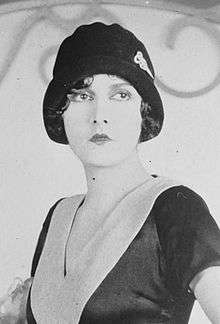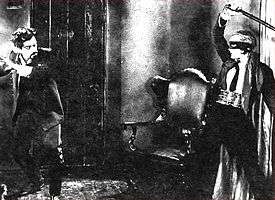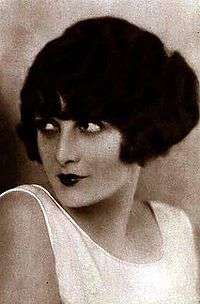Evelyn Brent
| Evelyn Brent | |
|---|---|
 | |
| Born |
Mary Elizabeth Riggs October 20, 1901 Tampa, Florida, U.S. |
| Died |
June 4, 1975 (aged 73) Los Angeles, California, U.S. |
| Occupation | Actress |
| Years active | 1915–1960 |
| Spouse(s) |
B. P. Fineman (m.1922–1927; divorced) Harry D. Edwards (1928–1947; divorced) Harry Fox (m.?–1959; his death) |

Evelyn Brent (October 20, 1901 – June 4, 1975)[1] was an American film and stage actress.
Early life
Born Mary Elizabeth Riggs in Tampa and known as Betty, she was a child of 10 when her mother Eleanor died, leaving her father Arthur to raise her alone. After moving to New York City as a teenager, her good looks brought modeling jobs that led to an opportunity to become involved in the still relatively new business of making motion pictures. She originally studied to be a teacher. While attending a normal school in New York she visited the World Film Studio in Fort Lee, New Jersey. Two days later she was working there as an extra making $3 a day.
Career
She began her film career working under her own name at a New Jersey film studio then made her major debut in the 1915 silent film production of the Robert W. Service poem, The Shooting of Dan McGrew.
As Evelyn Brent, she continued to work in film, developing into a young woman whose sultry looks were much sought after. After World War I, she went to London for a vacation. She met American playwright Oliver Cromwell who urged her to accept an important role in The Ruined Lady. The production was presented on the London stage. The actress remained in England for four years, performing in films produced by British companies. She also worked on stage there before going to Hollywood in 1922.
There, her career received a major boost the following year when she was chosen as one of the WAMPAS Baby Stars. Douglas Fairbanks Sr. signed her but failed to find a story for her; she left his company to join Associated Authors.

Evelyn went on to make more than two dozen silent films including three for the noted Austrian director Josef von Sternberg, including The Last Command (1928), an epic war drama for which Emil Jannings won the first Academy Award for Best Actor and featured a pivotal supporting performance for William Powell. Later that same year, she starred opposite William Powell in Paramount Pictures' (and her own) first talkie. One film, Interference (1928), did not live up to expectations at the box office. Not dissuaded, Brent played major roles in several more features, most notably The Silver Horde and the Paramount Pictures all-star revue Paramount on Parade (both 1930).
By the early part of the 1930s, she was busy working in secondary roles in a variety of films as well as touring with vaudeville shows.
By 1941 her screen career was at its least prestigious point. Now 45, too mature for ingenue roles, and no longer in demand by major studios, she found plenty of work at the smaller, low-budget studios. She photographed attractively opposite leading men who were also at advanced ages and later stages in their careers: Neil Hamilton in Producers Releasing Corporation's production Dangerous Lady, Lee Tracy in the same studio's The Payoff, and Jack Holt in the serial Holt of the Secret Service, produced by Larry Darmour for Columbia Pictures. Her performances were still persuasive, and her name was still recognizable to moviegoers: theater owners often put "Evelyn Brent" on their marquees. In the early 1940s she worked in the Pine-Thomas "B" action features for Paramount Pictures release. Veteran director William Beaudine cast her in many "B" productions, including Emergency Landing (1941), Bowery Champs (1944), The Golden Eye (1948), and Again Pioneers (1950). After performing in more than 120 films, she retired from acting in 1950 and worked for a number of years as an actor's agent.
Evelyn returned to acting in television's Wagon Train for one episode in 1960, The Lita Foladaire Story starring Ward Bond and Diane Brewster; Brent played a housekeeper.
Private life
Evelyn Brent was married three times: to movie executive Bernard P. Fineman, to producer Harry D. Edwards, and finally to the vaudeville actor Harry Fox for whom the foxtrot dance was named. They were still married when he died in 1959. [2][3]
Brent died of a heart attack in 1975 at her Los Angeles home. She was cremated and interred in the San Fernando Mission Cemetery in Mission Hills, California. For her contribution to the motion picture industry, she was honored with a star on the Hollywood Walk of Fame at 6548 Hollywood Blvd.
Filmography
- Silent, extant
- Raffles, the Amateur Cracksman (1917 L. Lawrence Weber/State's Rights)
- Border River (1919 Arrow)
- Fool's Gold (1919 Washington Motion Picture Co.)
- The Glorious Lady (1919 Selznick)
- Laughter and Tears (1921 Granger-Binger Films)
- Trapped by the Mormons (1922 Master Films)
- Arizona Express (1924 Fox)
- The Desert Outlaw (1924 Fox) (Czech Film Archive)
- The Cyclone Rider (1924 Fox) (Czech Film Archive)
- Midnight Molly (1925 Gothic Pictures/FBO) (British Film Institute)
- Broadway Lady (1925 Robertson-Cole/FBO) (Library of Congress)
- Love 'Em and Leave 'Em (1926 Paramount)
- Underworld (1927 Paramount)
- Women's Wares (1927 Tiffany Studios) (British Film Institute)
- The Last Command (1928 Paramount)
- The Showdown (1928 Paramount) (Library of Congress)
- A Night of Mystery (1928 Paramount) (UCLA Film & TV)
- The Mating Call (1928) (University of Nevada-Las Vegas)
- Silent, lost
- The Heart of a Painted Woman (1915 Popular Plays and Players)
- The Shooting of Dan McGrew (1915 Popular Plays and Players)
- When Love Laughs (1915 Independent Moving Pictures Company of America)
- The Lure of Heart's Desire (1916 Popular Plays and Players)
- The Iron Will (1916 Biograph Studios)
- The Soul Market (1916 Popular Plays and Players)
- Playing with Fire (1916 Popular Plays and Players)
- The Spell of the Yukon (1916 Popular Plays and Players)
- The Weakness of Strength (1916 Popular Plays and Players)
- The Iron Woman (1916)
- The Millionaire's Double (1917 Rolfe Photoplays)
- To the Death (1917 Metro Pictures)
- Who's Your Neighbor? (1917 Master Drama Features)
- Daybreak (1918 Metro)
- Help! Help! Police! (1919 Fox Film Corporation)
- The Other Man's Wife (1919 Carl Harbaugh)
- The Law Divine (1920 Master Films)
- The Shuttle of Life (1920 Phillips)
- Sonia (1921 Ideal Film Company)
- The Door That Has No Key (1921 Alliance Film Corp.)
- Sybil (1921 Ideal Film Company)
- Demos (1921 Ideal Film Company)
- Pages of Life (1922 Adelqui Migliar Productions)
- Married to a Mormon (1922 Master Films)
- The Experiment (1922 Stoll Picture Productions)
- The Spanish Jade (1922 Famous Players-Lasky/Paramount Pictures)
- Held to Answer (1923 Metro Pictures)
- Loving Lies (1924 Associated Authors)
- The Shadow of the Desert (1924 Fox Film)
- The Plunderer (1924 Fox)
- The Lone Chance (1924 Fox)
- The Dangerous Flirt (1924 Gothic Pictures/FBO)
- My Husband's Wives (1924 Fox)
- Silk Stocking Sal (1924 FBO)
- Forbidden Cargo (1925 Robertson-Cole/FBO)
- Alias Mary Flynn (1925 FBO)
- Smooth as Satin (1925 Robertson-Cole/FBO)
- Lady Robinhood (1925 Robertson-Cole/FBO) (trailer LoC)
- Three Wise Crooks (1925)
- Queen o'Diamonds (1926 Robertson-Cole/FBO)
- Secret Orders (1926 Robertson-Cole/FBO)
- The Impostor (1926 Gothic Pictures/FBO)
- The Jade Cup (1926 Gothic Pictures/FBO)
- Flame of the Argentine (1926 Robertson-Cole/FBO)
- Love's Greatest Mistake (1927)
- Blind Alleys (1927 Famous Players-Lasky/Paramount)
- Beau Sabreur (1928 Paramount)
- His Tiger Wife (1928 Paramount Pictures)
- The Drag Net (1928)
- Talking
- Interference (1928)
- Broadway (1929)
- Fast Company (1929)
- Woman Trap (1929)
- Why Bring That Up? (1929)
- Darkened Rooms (1929) (extant, Library of Congress)
- Slightly Scarlet (1930)
- Framed (1930)
- Paramount on Parade (1930)
- The Silver Horde (1930)
- Madonna of the Streets (1930)
- Traveling Husbands (1931)
- The Pagan Lady (1931)
- The Mad Parade (1931)
- High Pressure (1932)
- Attorney for the Defense (1932)
- The Crusader (1932)
- The Public Be Hanged (1933)
- Speed Limited (1935)
- Symphony of Living (1935)
- Home on the Range (1935)
- Without Children (1935)
- The Nitwits (1935)
- Song of the Trail (1936)
- It Couldn't Have Happened – But It Did (1936)
- One for All (1936)
- Hopalong Cassidy Returns (1936)
- Jungle Jim Shanghai Lil, one of four main characters(1937)
- King of Gamblers (1937)
- The Last Train from Madrid (1937)
- Night Club Scandal (1937)
- Sudden Bill Dorn (1937)
- Daughter of the Orient (1937)
- Tip-Off Girls (1938)
- Mr. Wong, Detective (1938)
- The Law West of Tombstone (1938)
- Panama Lady (1939)
- Daughter of the Tong (1939)
- The Mad Empress (1939)
- Emergency Landing (1941)
- Forced Landing (1941)
- Wide Open Town (1941)
- Dangerous Lady (1941)
- Holt of the Secret Service (1941)
- Westward Ho (1942)
- Wrecking Crew (1942)
- The Payoff (1942)
- Attorney for the Defense (1943)
- Spy Train (1943)
- The Seventh Victim (1943)
- Bowery Champs (1944)
- Raiders of the South (1947)
- Robin Hood of Monterey (1947)
- Stage Struck (1948)
- The Golden Eye (1948)
- Again... Pioneers (1950)

References
- ↑ Kear, Lynn (2009). Evelyn Brent: The Life and Films of Hollywood's Lady Crook. p. 7. ISBN 978-0-7864-4363-5.
- ↑ "Evelyn Brent". EvelynBrent.com. Retrieved 2011-09-01.
- ↑ Evelyn Brent: the life and films of Hollywood's Lady Crook. Retrieved 2011-09-01.
Bibliography
- New York Times, Evelyn Brent, 75, Film Star of 1920s, June 8, 1975, Page 55.
External links
| Wikimedia Commons has media related to Evelyn Brent. |
- Evelyn Brent at the Internet Movie Database
- Evelyn Brent at AllMovie
- Photographs of Evelyn Brent
- Evelyn Brent at Find a Grave